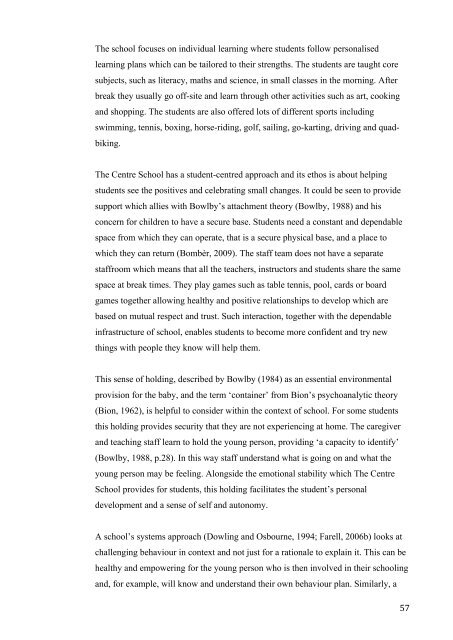Derrington 2012 thesis.pdf - Anglia Ruskin Research Online
Derrington 2012 thesis.pdf - Anglia Ruskin Research Online
Derrington 2012 thesis.pdf - Anglia Ruskin Research Online
You also want an ePaper? Increase the reach of your titles
YUMPU automatically turns print PDFs into web optimized ePapers that Google loves.
The school focuses on individual learning where students follow personalised<br />
learning plans which can be tailored to their strengths. The students are taught core<br />
subjects, such as literacy, maths and science, in small classes in the morning. After<br />
break they usually go off-site and learn through other activities such as art, cooking<br />
and shopping. The students are also offered lots of different sports including<br />
swimming, tennis, boxing, horse-riding, golf, sailing, go-karting, driving and quadbiking.<br />
The Centre School has a student-centred approach and its ethos is about helping<br />
students see the positives and celebrating small changes. It could be seen to provide<br />
support which allies with Bowlby’s attachment theory (Bowlby, 1988) and his<br />
concern for children to have a secure base. Students need a constant and dependable<br />
space from which they can operate, that is a secure physical base, and a place to<br />
which they can return (Bombèr, 2009). The staff team does not have a separate<br />
staffroom which means that all the teachers, instructors and students share the same<br />
space at break times. They play games such as table tennis, pool, cards or board<br />
games together allowing healthy and positive relationships to develop which are<br />
based on mutual respect and trust. Such interaction, together with the dependable<br />
infrastructure of school, enables students to become more confident and try new<br />
things with people they know will help them.<br />
This sense of holding, described by Bowlby (1984) as an essential environmental<br />
provision for the baby, and the term ‘container’ from Bion’s psychoanalytic theory<br />
(Bion, 1962), is helpful to consider within the context of school. For some students<br />
this holding provides security that they are not experiencing at home. The caregiver<br />
and teaching staff learn to hold the young person, providing ‘a capacity to identify’<br />
(Bowlby, 1988, p.28). In this way staff understand what is going on and what the<br />
young person may be feeling. Alongside the emotional stability which The Centre<br />
School provides for students, this holding facilitates the student’s personal<br />
development and a sense of self and autonomy.<br />
A school’s systems approach (Dowling and Osbourne, 1994; Farell, 2006b) looks at<br />
challenging behaviour in context and not just for a rationale to explain it. This can be<br />
healthy and empowering for the young person who is then involved in their schooling<br />
and, for example, will know and understand their own behaviour plan. Similarly, a<br />
! &(!
















